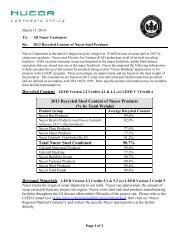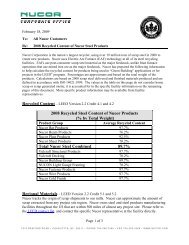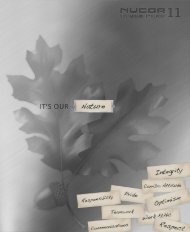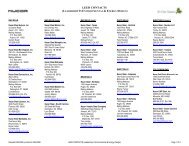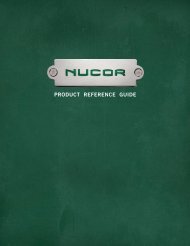Building Systems - Nucor
Building Systems - Nucor
Building Systems - Nucor
Create successful ePaper yourself
Turn your PDF publications into a flip-book with our unique Google optimized e-Paper software.
SAFETY DATA SHEET<br />
1. CHEMICAL PRODUCT AND COMPANY IDENTIFICATION<br />
Trade Name: Structural Steel Products<br />
CAS Number: Not applicable<br />
Synonyms: Steel, Purlins, Built-Up Joists and Trusses, Steel <strong>Building</strong> Components<br />
Use/Description: Structural products<br />
Company Identification: 24 Hour Contact – CHEMTREC 1-800-424-9300<br />
<strong>Nucor</strong> <strong>Building</strong> <strong>Systems</strong>-Texas<br />
600 Apache Trail<br />
Terrell, TX 75160<br />
Safety Officer [8:00 am – 5:00 pm]<br />
1-(972)-524-5407<br />
<strong>Nucor</strong> <strong>Building</strong> <strong>Systems</strong>- Indiana<br />
305 Industrial Parkway<br />
Waterloo, IN 46793<br />
Safety Officer [8:00 am – 5:00 pm]<br />
1-(260)-837-7891<br />
<strong>Nucor</strong> <strong>Building</strong> <strong>Systems</strong>- Utah<br />
1050 North Watery Lane<br />
Brigham City, UT 84302<br />
Safety Officer [8:00 am – 5:00 pm]<br />
1-(435)-919-3100<br />
<strong>Nucor</strong> <strong>Building</strong> <strong>Systems</strong>- South Carolina<br />
200 Whetstone Road<br />
Swansea, SC 29160<br />
Safety Officer [8:00 am – 5:00 pm]<br />
1-(803)-568-2100<br />
CBC Steel <strong>Building</strong>s<br />
1700 East Louise Avenue<br />
Lathrop, CA 95330<br />
Safety Officer [7:00 am – 3:30 pm] PST<br />
1-(209)-983-0910<br />
Gulf States Manufacturers<br />
101 Airport Road<br />
Starkville, MS 39759<br />
Safety Officer [8:00 am – 5:00 pm]<br />
1-(662)-323-8021<br />
American <strong>Building</strong>s Company – South Division<br />
1150 State Docks Road<br />
Eufaula, AL 36027<br />
Safety Officer [8:00 am – 5:00 pm]<br />
1-(334)-687-2032<br />
American <strong>Building</strong> Company – West Division<br />
2401 Conestoga Drive<br />
Carson City, NV 89706<br />
Safety Officer [7:00 am – 4:00 pm] PST<br />
1-(775)-887-2900<br />
American <strong>Building</strong> Company – Midwest Division<br />
2101 East Main<br />
El Paso, IL 61738<br />
Safety Officer [8:00 am – 5:00 pm]<br />
1-(309)-527-5420<br />
American <strong>Building</strong> Company – Atlantic Division<br />
501 Golden Eagle Drive<br />
La Crosse, VA 23950<br />
Safety Officer [8:00 am – 5:00 pm]<br />
1-(434)-757-2220<br />
Kirby <strong>Building</strong> <strong>Systems</strong><br />
124 Kirby Drive<br />
Portland, TN 37148<br />
Safety Officer [8:00 am – 5:00pm]<br />
1-(615)-325-4165<br />
NUCONSTEEL<br />
525 South Locust<br />
Denton, Texas 76201<br />
Safety Officer [8:00 am – 5:00 pm]<br />
1-(940)-891-3050<br />
Page 1 of 9 Revision Date: 12/04/2013
Carbon and Alloy Steels<br />
2. HAZARDS IDENTIFICATION<br />
EMERGENCY OVERVIEW<br />
STEEL PRODUCTS AS SOLD BY NUCOR ARE NOT HAZARDOUS PER OSHA GHS 29 CFR 1910,<br />
1915, 1926. However, individual customer processes, (such as welding, sawing, brazing, grinding, abrasive<br />
blasting, and machining) may result in the formation of fumes, dust (combustible or otherwise), and/or<br />
particulate that may present the following hazards:<br />
OSHA Hazards:<br />
Carcinogen<br />
Skin Sensitizer<br />
Target Organ Effect – Lungs<br />
GHS Classification: Carcinogenicity (Category 2)<br />
Skin Sensitization (Category 1)<br />
Specific Target Organ Toxicity-Repeated Exposure (Category 1)<br />
Pictogram(s):<br />
Signal Word:<br />
Danger<br />
Hazard Statement(s)<br />
H317: Dust/fumes may cause an allergic skin reaction.<br />
H351: Dust/fumes suspected of causing cancer via inhalation.<br />
H372: Inhalation of dust/fumes causes damage to respiratory tract through prolonged or repeated exposure<br />
Precautionary Statement(s)<br />
P202: Do not handle until all safety precautions have been read and understood.<br />
P261: Avoid breathing dust/fumes.<br />
P281: Use personal protective equipment as required.<br />
P308+P313: If exposed or concerned: Get medical advice/attention.<br />
Potential Health Effects<br />
Eye Contact<br />
Dusts or particulates may cause mechanical irritation including pain, tearing, and redness. Scratching of<br />
the cornea can occur if eye is rubbed. Fumes may be irritating. Contact with the heated material may<br />
cause thermal burns.<br />
Skin Contact<br />
Dusts or particulates may cause mechanical irritation due to abrasion. Coated steel may cause skin<br />
irritation in sensitive individuals (see Section 16 for additional information.) Some components in this<br />
product are capable of causing an allergic reaction, possibly resulting in burning, itching and skin eruptions.<br />
Contact with heated material may cause thermal burns.<br />
Inhalation<br />
Dusts may cause irritation of the nose, throat, and lungs. Excessive inhalation of metallic fumes and dusts<br />
may result in metal fume fever, an influenza-like illness. It is characterized by a sweet or metallic taste in<br />
the mouth, accompanied by dryness and irritation of the throat, cough, shortness of breath, pulmonary<br />
edema, general malaise, weakness, fatigue, muscle and joint pains, blurred vision, fever and chills. Typical<br />
symptoms last from 12 to 48 hours.<br />
Ingestion<br />
Not expected to be acutely toxic via ingestion based on the physical and chemical properties of the<br />
product. Swallowing of excessive amounts of the dust may cause irritation, nausea, and diarrhea.<br />
Potential Fire and Explosion Hazards<br />
Page 2 of 9 Revision Date: 12/04/2013
Carbon and Alloy Steels<br />
Under normal conditions, steel products do not present fire or explosion hazards, and dust generated by<br />
handling steel products is oxidized and not combustible. Processing of steel product by some individual<br />
customers may produce potentially combustible dust that may represent a fire or explosion hazard.<br />
Chronic or Special Toxic Effects<br />
Repeated exposure to fine dusts may inflame the nasal mucosa and cause changes to the lung. In<br />
addition, a red-brown pigmentation of the eye and/or skin may occur. Welding fumes have been associated<br />
with adverse health effects. Contains components that may cause cancer or reproductive effects. The<br />
following components are listed by NTP, OSHA, or IARC as carcinogens: Nickel, chromium (hexavalent),<br />
cobalt, lead, cadmium, antimony (trioxide), arsenic, beryllium. See Section 11, for additional, specific<br />
information on effects noted above.<br />
Target Organs<br />
Overexposure to specific components of this product that are generated in dusts or fumes may cause<br />
adverse effects to the following organs or systems: eyes, skin, liver, kidney, central nervous system,<br />
cardiovascular system, respiratory system,.<br />
Medical Conditions Aggravated by Exposure<br />
Diseases of the skin such as eczema may be aggravated by exposure. Also, disorders of the respiratory<br />
system including asthma, bronchitis, and emphysema. Long-term inhalation exposure to agents that cause<br />
pneumoconiosis (e.g. dust) may act synergistically with inhalation of oxide fumes or dusts of this product.<br />
3. COMPOSITION/INFORMATION ON INGREDIENTS<br />
Components CAS No. % Weight Exposure Limits<br />
Base Metal:<br />
ACGIH TLV (mg/m 3 ) OSHA PEL (mg/m 3 )<br />
Iron (Fe) 7439-89-6 Balance 5 Oxide Dust/Fume 10 Oxide Dust/Fume<br />
Alloying<br />
Elements<br />
Aluminum (Al) 7429-90-5 0-3.0 10<br />
5<br />
Dust<br />
Fume<br />
15<br />
5<br />
Dust<br />
Respirable fraction<br />
Antimony (Sb) 7440-36-0
Carbon and Alloy Steels<br />
Components CAS No. % Weight Exposure Limits<br />
Silicon (Si) 7440-21-3<br />
Sulfur (S) 7446-09-<br />
05<br />
0-5.0<br />
Carbon and Alloy Steels<br />
6. ACCIDENTAL RELEASE MEASURES<br />
Precautions if Material is Spilled or Released - Emergency response is unlikely unless in the form of<br />
combustible dust. Avoid inhalation, eye, or skin contact of dusts by using appropriate precautions outlined<br />
in this SDS (see section 8). Fine turnings and small chips should be swept or vacuumed and placed into<br />
appropriate disposable containers. Keep fine dust or powder away from sources of ignition. Scrap should<br />
be reclaimed for recycling. Prevent materials from entering drains, sewers, or waterways. Specific<br />
standards and regulations may be applicable to materials generated by individual customer processes. As<br />
appropriate, these standards and regulations should be consulted for applicability.<br />
Fire and Explosion Hazards - Some customer processes may generate combustible dust that may require<br />
specific precautions when cleaning spills or releases of dust.<br />
Environmental Precautions - Some grades of steel may contain reportable quantities of alloying<br />
elements. See Section 15 for additional information.<br />
Waste Disposal Methods - Dispose used or unused product in accordance with applicable Federal, State,<br />
and Local regulations. Please recycle.<br />
7. HANDLING AND STORAGE<br />
Storage Temperatures - Stable under normal temperatures and pressures.<br />
Precautions to be Taken in Handling and Storing - Store away from strong oxidizers. Dusts and/or<br />
powders, alone, or combined with process specific fluids, may form explosive mixtures with air. Applicable<br />
Federal, state and local laws and regulations may require testing dust generated from processing of steel<br />
products to determine if it represents a fire or explosion hazard and to determine appropriate protection<br />
methods. Avoid breathing dusts or fumes.<br />
8. EXPOSURE CONTROLS/PERSONAL PROTECTION<br />
Operations with potential for generating high concentrations of airborne particulates or fumes should be<br />
evaluated and controlled as necessary.<br />
Eye Protection - Use safety glasses. Dust resistant safety goggles are recommended under<br />
circumstances where particles could cause mechanical injury such as grinding or cutting. Face shield<br />
should be used when welding or cutting.<br />
Skin - Appropriate protective gloves should be worn as necessary. Good personal hygiene practices<br />
should be followed including cleansing exposed skin several times daily with soap and water, and<br />
laundering or dry cleaning soiled work clothing.<br />
Respiratory Protection - NIOSH/MSHA approved dust/fume/mist respirator should be used to avoid<br />
excessive exposure. See Section 3 for component material information exposure limits. If such<br />
concentrations are sufficiently high that this respirator is inadequate, or high enough to cause oxygen<br />
deficiency, use a positive pressure self-contained breathing apparatus (SCBA). Follow all applicable<br />
respirator use, fitting, and training standards and regulations.<br />
Ventilation - Provide general and/or local exhaust ventilation to control airborne levels of dust or fumes<br />
below exposure limits.<br />
Exposure Guidelines - No permissible exposure limits (PEL) or threshold limit values (TLV) exist for steel.<br />
See Section 3 for component materials. Various grades of steel will contain different combinations of these<br />
elements. Trace elements may also be present in minute amounts.<br />
9. PHYSICAL AND CHEMICAL PROPERTIES<br />
Appearance and Odor - Red, Grey or other color steel panels, purlins, and built-up joists and trusses<br />
Boiling Point - Not applicable<br />
Melting Point - Approximately 2800 o F<br />
pH - Not applicable<br />
Specific Gravity (at 15.6 o C) - Not applicable<br />
Density (at 15.6 o C) - Not applicable<br />
Page 5 of 9 Revision Date: 12/04/2013
Carbon and Alloy Steels<br />
Vapor Pressure - Not applicable<br />
Vapor Density (air = 1) - Not applicable<br />
% Volatile, by Volume - Not applicable<br />
Solubility in Water - Insoluble.<br />
Evaporation Rate (Butyl Acetate = 1) - Not applicable<br />
Other Physical and Chemical Data - None<br />
10. STABILITY AND REACTIVITY<br />
Stability - Stable<br />
Conditions to Avoid - Steel at temperatures above the melting point may liberate fumes containing oxides<br />
of iron and alloying elements. Avoid generation of airborne fume.<br />
Hazardous Polymerization - Will not occur.<br />
Incompatibility (Materials to Avoid) - Reacts with strong acids to form hydrogen gas. Do not store near<br />
strong oxidizers.<br />
Hazardous Decomposition Products - Metallic fumes may be produced during welding, burning, grinding,<br />
and possibly machining or any situation with the potential for thermal decomposition. Refer to ANSI Z49.1<br />
11. TOXICOLOGICAL INFORMATION<br />
The primary component of this product is iron. Long-term exposure to iron dusts or fumes can result in a<br />
condition called siderosis which is considered to be a benign pneumoconiosis. Symptoms may include<br />
chronic bronchitis, emphysema, and shortness of breath upon exertion. Penetration of iron particles in the<br />
skin or eye may cause an exogenous or ocular siderosis which may be characterized by a red-brown<br />
pigmentation of the affected area. Ingestion overexposures to iron may affect the gastrointestinal, nervous,<br />
and hematopoietic system and the liver. Iron and steel founding, but not iron or iron oxide, has been listed<br />
as carcinogenic (Group 1) by IARC.<br />
When this product is welded, fumes are generated. Welding fumes may be different in composition from<br />
the original welding product, with the chief component being ordinary oxides of the metal being welded.<br />
Chronic health effects (including cancer) have been associated with the fumes and dusts of individual<br />
component metals (see above), and welding fumes as a general category have been listed by IARC as a<br />
carcinogen (Group 2B). There is also limited evidence that welding fumes may cause adverse reproductive<br />
and fetal effects. Evidence is stronger where welding materials contain known reproductive toxins, e.g.,<br />
lead which may be present in the coating material of this product.<br />
Breathing fumes or dusts of this product may result in metal fume fever, which is an illness produced by<br />
inhaling metal oxides. These oxides are produced by heating various metals including cadmium, zinc,<br />
magnesium, copper, antimony, nickel, cobalt, manganese, tin, lead, beryllium, silver, chromium, aluminum,<br />
selenium, iron, and arsenic. The most common agents involved are zinc and copper.<br />
This product may contain small amounts of manganese. Prolonged exposure to manganese dusts or<br />
fumes is associated with "manganism", a Parkinson-like syndrome characterized by a variety of<br />
neurological symptoms including muscle spasms, gait disturbances, tremors, and psychoses.<br />
This product may contain small amounts of cadmium. Primary target organs for cadmium overexposure<br />
are the lung and the kidney. Because of its cumulative nature, chronic cadmium poisoning can cause<br />
serious disease which takes many years to develop and may continue to progress despite cessation of<br />
exposure. Progression of the disease may not reflect current exposure conditions. It is also capable of<br />
causing a painful osteomalacia called “Itai-Itai” in postmenopausal women, and has caused developmental<br />
effects and/or reproductive effects in male and female animals. Cadmium is a listed carcinogen by NTP,<br />
OSHA, and IARC (Group 1).<br />
This product may contain small amounts of chromium. Prolonged and repeated overexposure to chromium<br />
dusts or fumes may cause skin ulcers, nasal irritation and ulceration, kidney damage and cancer of the<br />
respiratory system. Chromium is skin sensitizer. Cancer is generally attributed to the hexavalent (+6) form<br />
of chromium which is listed as a carcinogen by NTP and IARC (Group 1).<br />
Page 6 of 9 Revision Date: 12/04/2013
Carbon and Alloy Steels<br />
This product may contain small amounts of nickel. Prolonged and repeated contact with nickel may cause<br />
sensitization dermatitis. Inhalation of nickel compounds has caused lung damage as well as sinus, nasal<br />
and lung cancer in laboratory animals. Nickel is a listed carcinogen by NTP and IARC (Group 1).<br />
This product may contain small amounts of vanadium. Adverse effects from dermal, inhalation or<br />
parenteral exposure to various vanadium compounds have been reported. The major target for vanadium<br />
pentoxide toxicity is the respiratory tract. Fumes or dust can cause severe eye and respiratory irritation,<br />
and systemic effects. Chronic bronchitis, green tongue, conjunctivitis, pharyngitis, rhinitis, rales, chronic<br />
productive cough, and tightness of the chest have been reported following overexposure. Allergic<br />
reactions resulting from skin and inhalation exposures have also been reported. A statistical association<br />
between vanadium air levels and lung cancer has been suggested, but vanadium currently is not regarded<br />
as a human carcinogen.<br />
This product may contain small amounts of lead. Lead can accumulate in the body. Consequently,<br />
exposure to fumes or dust may produce signs of polyneuritis, diminished vision and peripheral neuropathy,<br />
such as tingling and loss of feeling in fingers, arms and legs. Lead is a known reproductive and<br />
developmental toxin. It is also associated with central nervous system disorders, anemia, kidney<br />
dysfunction and neurobehavioral abnormalities. The brain is a major target organ for lead exposure.<br />
Elemental lead is listed as an IARC 2B carcinogen.<br />
The product may contain small amounts of copper. Copper dust and fumes can irritate the eyes, nose and<br />
throat causing coughing, wheezing, nosebleeds, ulcers and metal fume fever. Other effects from repeated<br />
inhalation of copper fumes include a metallic or sweet taste, and discoloration of skin, teeth or hair.<br />
Copper also may cause an allergic skin reaction. Overexposure to copper can affect the liver.<br />
12. ECOLOGICAL INFORMATION<br />
Aquatic Ecotoxicological Data - No specific information available on this product.<br />
Environmental Fate Data - No specific information available on this product.<br />
13. DISPOSAL CONSIDERATIONS<br />
Recovery and reuse, rather than disposal, should be the ultimate goal of handling efforts. Dispose in<br />
accordance with federal, state, and local health and environmental regulations. Prevent materials from<br />
entering drains, sewers, or waterways.<br />
DOT Proper Shipping Name - Not regulated<br />
DOT Hazard Classification - Not regulated<br />
UN/NA Number - Not applicable<br />
DOT Packing Group - Not applicable<br />
Labeling Requirements - Not applicable<br />
Placards - Not applicable<br />
DOT Hazardous Substance - Not applicable<br />
DOT Marine Pollutant - Not applicable<br />
14. TRANSPORT INFORMATION<br />
15. REGULATORY INFORMATION<br />
This product is not hazardous under the criteria of the Federal OSHA Hazard Communication Standard 29<br />
CFR 1910.1200. However, dusts and fumes from this product may be combustible or hazardous and<br />
require protection to comply with applicable Federal, state and local laws and regulations.<br />
California Proposition 65: This product contains chemicals (antimony [oxide], arsenic, beryllium,<br />
chromium [hexavalent], cobalt, cadmium, lead, nickel) known to the State of California to cause<br />
Page 7 of 9 Revision Date: 12/04/2013
Carbon and Alloy Steels<br />
cancer and chemicals (cadmium, lead) known to the State of California to cause birth defects or<br />
other reproductive harm.<br />
Massachusetts Substance List: Aluminum, Antimony, Arsenic, Beryllium, Boron, Cadmium, Chromium,<br />
Cobalt, Copper, Lead, Magnesium, Manganese, Molybdenum, Nickel, Nitrogen, Phosphorus,<br />
Selenium, Silicon, Sulfur, Tin, Titanium, Tungsten, Vanadium, Zinc<br />
Pennsylvania Hazardous Substance List: Aluminum, Antimony, Arsenic, Beryllium, Boron, Cadmium,<br />
Chromium, Cobalt, Copper, Lead, Magnesium, Manganese, Molybdenum, Nickel, Nitrogen,<br />
Phosphorus, Selenium, Silicon, Sulfur, Tin, Titanium, Tungsten, Vanadium, Zinc<br />
New Jersey Hazardous Substance List: Aluminum, Antimony, Arsenic, Beryllium, Boron, Cadmium,<br />
Chromium, Cobalt, Copper, Lead, Magnesium, Manganese, Molybdenum, Nickel, Nitrogen,<br />
Phosphorus, Selenium, Silicon, Sulfur, Tin, Titanium, Tungsten, Vanadium, Zinc<br />
Toxic Substances Control Act (TSCA)<br />
Components of this product are listed on the TSCA Inventory.<br />
Comprehensive Environmental Response, Compensation and Liability Act (CERCLA)<br />
Steel is not reportable, however, it contains hazardous substances that may be reportable if released in<br />
pieces with diameters less than or equal to 0.004 inches (RQ marked with a “*”).<br />
Chemical Name<br />
Reportable Quantity (in lb)<br />
Antimony 5000*<br />
Arsenic 1*<br />
Beryllium 10*<br />
Cadmium 10*<br />
Chromium 5000*<br />
Copper 5000*<br />
Lead 10*<br />
Nickel 100*<br />
Phosphorus 1<br />
Selenium 100*<br />
Zinc 1000*<br />
Superfund Amendments and Reauthorization Act of 1986 (SARA), Title III<br />
SECTION 311/312 HAZARD CATEGORIES: Immediate Health Effect, Delayed Health Effect<br />
This product contains the following EPCRA Section 313 chemicals subject to the reporting requirements of<br />
section 313 of the Emergency Planning and Community Right – To – Know Act of 1986 (40 CFR 372):<br />
SECTION 313 REPORTABLE INGREDIENTS:<br />
Chemical Name CAS Number Concentration (% by weight) Reportable<br />
Aluminum 7429-90-5 0.0-0.01 Some grades up to 3.0% Yes – Greater than 0.1%<br />
Antimony 7440-36-0
Carbon and Alloy Steels<br />
Concentrations based on analytical data and process knowledge of typical products distributed by the facility.<br />
16. OTHER INFORMATION<br />
This SDS covers <strong>Nucor</strong> product as delivered from the <strong>Nucor</strong> facility, but does not include chemicals that<br />
may be applied by subsequent handlers and/or distributors of this product. This could include a variety of<br />
materials including oils, paints, galvanization, etc. that are not included in this SDS. Additionally, specialty<br />
orders may require application of coating material not listed in this SDS. SDSs for any <strong>Nucor</strong>-applied<br />
specialty coating will be provided separately. During welding, precautions should be taken for airborne<br />
contaminants that may originate from components of the welding rod. Arc or spark generated when<br />
welding or burning could be a source of ignition for combustible and/or flammable materials. The<br />
information in this Safety Data Sheet (SDS) was obtained from sources which we believe are reliable;<br />
however, the information is provided without any representation or warranty, expressed or implied,<br />
regarding the accuracy or correctness. The conditions or methods of handling, storage, use and disposal<br />
of the product are beyond our control and may be beyond our knowledge. For this and other reasons, we<br />
do not assume responsibility and expressly disclaim liability for loss, damage, or expense arising out of or<br />
in any way connected with the handling, storage, use, or disposal of this product.<br />
Page 9 of 9 Revision Date: 12/04/2013



